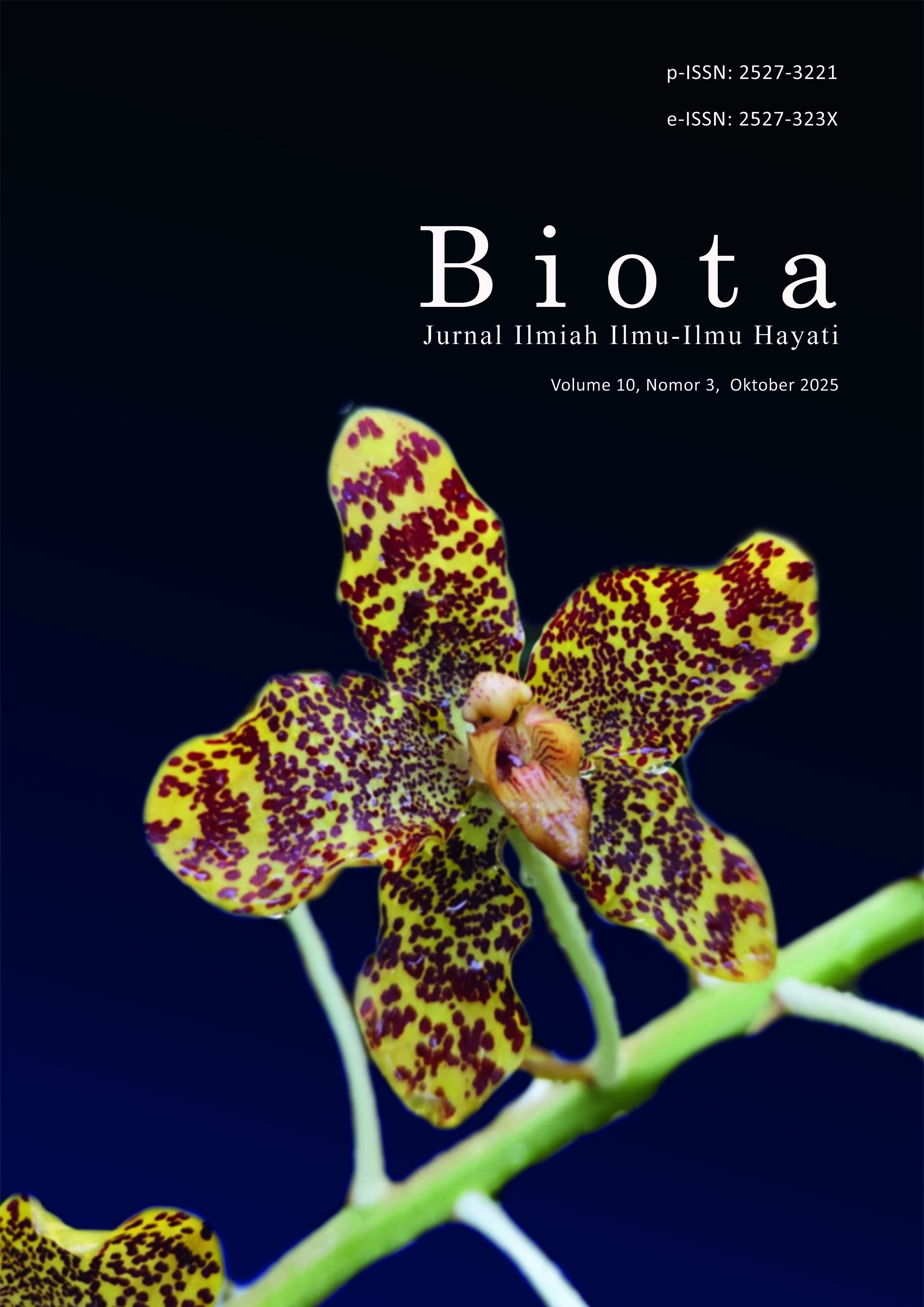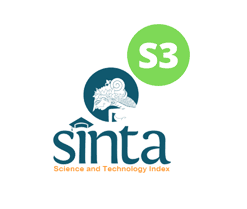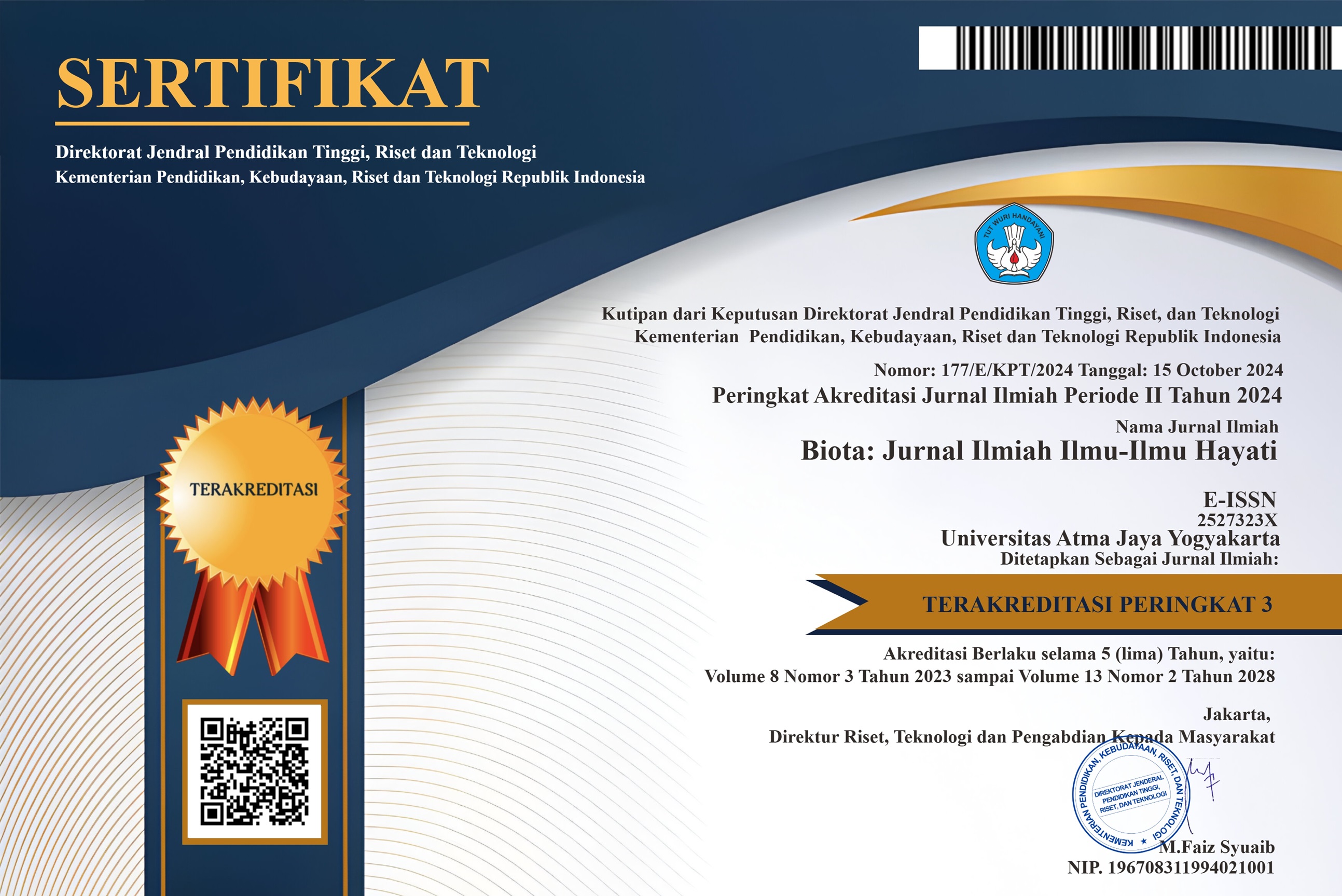The Enhancing Capsicum annuum L. Disease Resistance with Carrier and BSF Larval Gut Microbes
DOI:
https://doi.org/10.24002/biota.v10i3.11211Keywords:
Agriculture, carrier, biofungicide, disease resistance, red chiliAbstract
Red chili (Capsicum annuum L.) is one of the essential vegetable commodities in Indonesia. Nevertheless, the production of red chili is affected by disease due to fungal infection. Previous research showed that the consortial formulation of bacterial and Trichoderma without a carrier from Black Soldier Fly (Hermetia illucens) larva gut enhanced the disease resistance of red chili. Regardless, the research has not overcome several diseases caused by fungal infection. This study aims to analyze the effect of adding kaolin, talc, and zeolite as carriers with bacterial and Trichoderma consortia from BSF larval gut on the disease resistance of red chili caused by fungal infection. This experimental study was carried out in a randomized block design. The treatments were consortial of bacterial and Trichoderma + carrier kaolin (BTrK), talc (BTrT), zeolite (BTrZ), positive control of consortial without a carrier (K+(1)), positive control of inorganic treatment (K+(2)), and negative control of plants without treatment (K(-)). The results were analyzed by calculating disease incidence (DI) and severity intensity (SI) scores to determine disease resistance. New findings prove that BTrK enhanced resistance to fungal infection, namely cercospora leaf spot, leaf rust, and powdery mildew. BTrT formulation enhanced resistance to symptom severity. The study concluded that carrier formulation enhanced the resistance of red chili.
References
Aditya, R. H., Wahyuni, W. S., Universitas Jember, Indonesia, Mihardjo, P. A., & Universitas Jember, Indonesia. (2015). Ketahanan lapangan lima genotipe padi terhadap penyakit hawar daun bakteri. Jurnal Fitopatologi Indonesia 11(5): 159–165. https://doi.org/10.14692/jfi.11.5.159.
Aglave, B. (2019). Handbook of Plant Disease Identification and Management. CRC Press, Taylor & Francis Group. https://books.google.co.id/books?id=AF1ZtgEACAAJ.
Aksani, D., Surono, Ginting, R. C. B., & Purwani, J. (2021). The assay of carrier material and bacteria isolate formula as a biofertilizer on soybean in Inceptisols from West Java. IOP Conference Series: Earth and Environmental Science 648(1): 012193. https://doi.org/10.1088/1755-1315/648/1/012193.
Azwin, A., Suhesti, E., & Ervayenri, E. (2022). Analisis tingkat kerusakan serangan hama dan penyakit di persemaian bpdashl indragiri rokan pekanbaru. Wahana Forestra: Jurnal Kehutanan 17(1): 85–101. https://doi.org/10.31849/forestra.v17i1.8376.
Badan Pusat Statistik. (2024). Average weekly consumption per capita of some essential food items 2007-2024, from https://Www.Bps.Go.Id/Statictable/2014/09/08/950/Rata-Rata-Konsumsi-per-Kapita-Seminggu-Beberapa-Macam-Bahan-Makanan-Penting-2007-2017.Html%20. https://www.bps.go.id/statictable/2014/09/08/950/rata-rata-konsumsi-per-kapita-seminggu-beberapa-macam-bahan-makanan-penting-2007-2017.html%20.
Beka, B., & Pichiah, G. (2021). Response of hot pepper (Capsicum annuum L.) to major fungal diseases under field and greenhouse conditions in Horo Guduru Wollega, Oromia, Ethiopia. African Journal of Agricultural Research 17(6): 923–932. https://doi.org/10.5897/AJAR2020.14967.
BMKG. (2024). Data Iklim Harian BMKG, from https://Dataonline.Bmkg.Go.Id/.
Cataldo, E., Salvi, L., Paoli, F., Fucile, M., Masciandaro, G., Manzi, D., Masini, C. M., & Mattii, G. B. (2021). Application of zeolites in agriculture and other potential uses: a review. Agronomy 11(8): 1547. https://doi.org/10.3390/agronomy11081547.
Deb, D., Khan, A., & Dey, N. (2020). Phoma diseases: epidemiology and control. Plant Pathology 69(7): 1203–1217. https://doi.org/10.1111/ppa.13221.
Hafsah, S., Nura, N., Firdaus, F., & Amelia, P. (2023). Uji ketahanan penyakit antraknosa yang disebabkan oleh Colletotrichum gloesporioides pada populasi (m3) cabai lokal aceh. Jurnal Agrotek Lestari 8(2): 194–204.
Karaca, U. Ç., Atmaca, E., & Eken, N. (2023). The effects of different carrier materials on some morphological characteristics of rhizobium phaseoli. International Journal of Agricultural and Natural Sciences 16(1): 52–63.
Kristi, M., Sanjaya, Y., & Kusnadi, K. (2024). Pengaruh pemberian bakteri dan trichoderma viride dari isolat usus larva black soldier fly (BSF) terhadap ketahan penyakit cabai keriting (Capsicum annuum). Paspalum: Jurnal Ilmiah Pertanian 12(1): 100–110.
Martinez, Y., Ribera, J., Schwarze, F. W. M. R., & De France, K. (2023). Biotechnological development of Trichoderma-based formulations for biological control. Applied Microbiology and Biotechnology 107(18): 5595–5612. https://doi.org/10.1007/s00253-023-12687-x.
Merges, D., Bálint, M., Schmitt, I., Böhning‐Gaese, K., & Neuschulz, E. L. (2018). Spatial patterns of pathogenic and mutualistic fungi across the elevational range of a host plant. Journal of Ecology 106(4): 1545–1557. https://doi.org/10.1111/1365-2745.12942.
Myo, E. M., Ge, B., Ma, J., Cui, H., Liu, B., Shi, L., Jiang, M., & Zhang, K. (2019). Indole-3-acetic acid production by Streptomyces fradiae NKZ-259 and its formulation to enhance plant growth. BMC Microbiology 19(1): 155. https://doi.org/10.1186/s12866-019-1528-1.
Nazarov, P. A., Baleev, D. N., Ivanova, M. I., Sokolova, L. M., & Karakozova, M. V. (2020). Infectious plant diseases: Etiology, current status, problems and prospects in plant protection. Acta Naturae 12(3): 46–59. https://doi.org/10.32607/actanaturae.11026.
Ownley, B. H., Gwinn, K. D., & Vega, F. E. (2010). Endophytic fungal entomopathogens with activity against plant pathogens: Ecology and evolution. BioControl 55(1): 113–128. https://doi.org/10.1007/s10526-009-9241-x.
Patel, P., Patel, K., Dhandhukia, P., & Thakker, J. N. (2021). Plant growth promoting traits of marine Micrococcus sp. With bio-control ability against fusarium in chickpea plant. Vegetos 34(1): 94–101. doi: https://doi.org/10.1007/s42535-021-00191-4.
Poulaki, E. G., Gkizi, D., & Tjamos, S. E. (2020). Potential of zeolite to control Sclerotinia sclerotiorum and Rhizoctonia solani in lettuce and the induction of defence‐related genes. Journal of Phytopathology 168(2): 113–119. https://doi.org/10.1111/jph.12875.
Rozi, F. Z., Febrianti, Y., Program Studi Pendidikan Biologi STKIP PGRI Lubuklinggau, Telaumbanua, Y., & Program Studi Pendidikan Biologi STKIP PGRI Lubuklinggau. (2018). Potensi sari pati gadung (Dioscorea hispida l.) Sebagai bioinsektisida hama walang sangit pada tanaman padi (Oryza sativa L.). Biogenesis: Jurnal Ilmiah Biologi 6(1): 18–22. https://doi.org/10.24252/bio.v6i1.4185.
Rui-Hong, W., Tay Chia-Chay, Li He, & Liu Zhao. (2023). Preparation and properties of kaolin based slow-release fertilizer. Journal of Advanced Research in Applied Sciences and Engineering Technology 30(2): 205–215. https://doi.org/10.37934/araset.30.2.205215.
Sanjaya, Y., Safrudin, W. H., & Kusnadi, S. (2023). Identification of microflora from intestine of black soldier fly larvae (Hermetia illucens) and its application for vegetative growth of tomato (Lycopersicum esculentum). Journal of Entomological Research 47(1): 218–222.
Singh, J. G., Veer Singh B, A. G., Kumar Upadhayay, V., & Khan B, A. G. (2020). Comparative evaluation of developed carrier based bioformulations bearing multifarious pgp properties and their effect on shelf life under different storage conditions. Environment and Ecology 38: 96-103.
Sohaib, M., Zahir, Z. A., Khan, M. Y., Ans, M., Asghar, H. N., Yasin, S., & Al-Barakah, F. N. I. (2020). Comparative evaluation of different carrier-based multi-strain bacterial formulations to mitigate the salt stress in wheat. Saudi Journal of Biological Sciences 27(3): 777–787. https://doi.org/10.1016/j.sjbs.2019.12.034
Souza, R. D., Ambrosini, A., & Passaglia, L. M. P. (2015). Plant growth-promoting bacteria as inoculants in agricultural soils. Genetics and Molecular Biology 38(4): 401–419. https://doi.org/10.1590/S1415-475738420150053
Supriya, B. K., Amaresh, Y. S., Kenganal, M., Raghavendra, B. T., Hiregoudar, S., & Shakeel JT, J. T. (2024). Mechanical synthesis of nano carrier based bio-formulation of trichoderma harzianum and their bio-efficacy against fusarium wilt of chick pea. International Journal of Plant & Soil Science 36(4): 378–385.
Sutarman, S., & Prahasti, T. (2022). Uji keragaan trichoderma sebagai pupuk hayati dalam meningkatkan pertumbuhan dan produksi tanaman bawang merah. Jurnal Agrotek Tropika 10(3): 421. https://doi.org/10.23960/jat.v10i3.5737.
Warduna, R., Elvinardewi, E., Adam, I., Sianturi, D., Ruhimat, M., Hidayat, C. R., & Tyasningsiwi, R. W. (2011). Buku Saku Pengamatan Organisme Pengganggu Tumbuhan (OPT) Hortikultura (Bawang Merah, Cabai Merah, Kubis, Tomat dan Kentang).
Yassin, M. T., Mostafa, A. A.-F., Al-Askar, A. A., Sayed, S. R. M., & Rady, A. M. (2021). Antagonistic activity of Trichoderma harzianum and Trichoderma viride strains against some fusarial pathogens causing stalk rot disease of maize, in vitro. Journal of King Saud University - Science 33(3): 101363. https://doi.org/10.1016/j.jksus.2021.101363.
Yi, Y., Luan, P., Liu, S., Shan, Y., Hou, Z., Zhao, S., Jia, S., & Li, R. (2022). Efficacy of Bacillus subtilis XZ18-3 as a biocontrol agent against Rhizoctonia cerealis on wheat. Agriculture 12(2): 258. https://doi.org/10.3390/agriculture12020258.
Zhineng, Y., Ying, M., Bingjie, T., Rouxian, Z., & Qiang, Z. (2021). Intestinal microbiota and functional characteristics of black soldier fly larvae (Hermetia illucens). Annals of Microbiology 71(1): 13. https://doi.org/10.1186/s13213-021-01626-8.
Downloads
Published
How to Cite
Issue
Section
License
Copyright (c) 2025 Azmah Nururrahmani, Yayan Sanjaya, Hernawati

This work is licensed under a Creative Commons Attribution-NonCommercial 4.0 International License.
Authors who publish with Biota : Jurnal Ilmiah Ilmu-Ilmu Hayati agree to the following terms:
- Authors retain copyright and grant the Biota : Jurnal Ilmiah Ilmu-Ilmu Hayati right of first publication. Licensed under a Creative Commons Attribution-NonCommercial 4.0 International License that allows others to share the work with an acknowledgment of the work's authorship and initial publication in this journal.
- Authors are able to enter into separate, additional contractual arrangements for the non-exclusive distribution of the journal's published version of the work (e.g., post it to an institutional repository or publish it in a book), with an acknowledgment of its initial publication in Biota : Jurnal Ilmiah Ilmu-Ilmu Hayati, and as long as Author is not used for commercial purposes.













